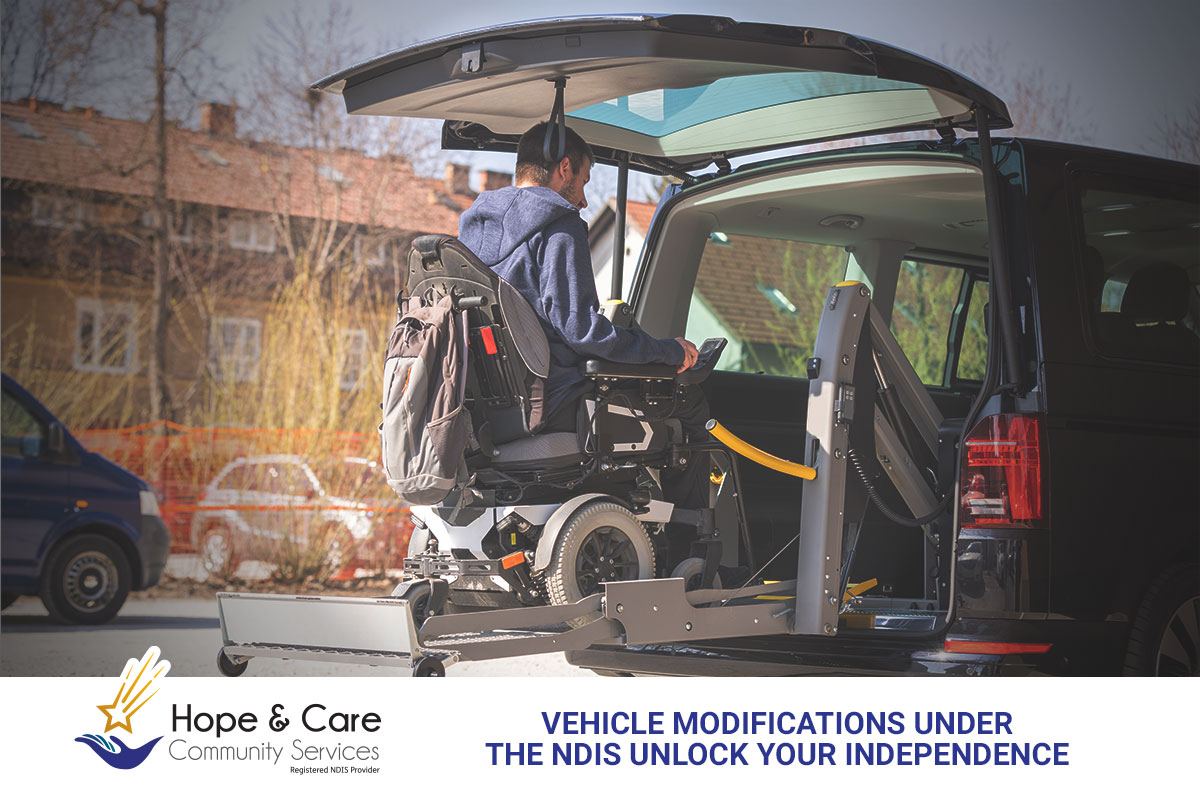
Mobility is key to independence and for individuals with disabilities, having access to a modified vehicle can open up a world of opportunities. The National Disability Insurance Scheme (NDIS) provides funding for vehicle modifications, ensuring participants can drive safely or travel comfortably.
At Hope & Care Community Services, we are committed to helping you understand how NDIS vehicle modifications work and how they can improve your everyday life. This guide will walk you through everything you need to know, from eligibility requirements to the benefits of these modifications.
What Are Vehicle Modifications?
Vehicle modifications involve tailoring a vehicle to meet your unique disability-related needs. These changes make it possible for people with disabilities to drive or travel as passengers without difficulty.
For example:
- Drivers might need hand controls, foot pedal adjustments, or specialised steering systems.
- Passengers could benefit from wheelchair lifts, swivel seats, or customised seating arrangements.
- Secondary control systems like voice-activated switches make it easier to operate vehicle functions.
These modifications are designed to enhance safety, accessibility and comfort, ensuring you can stay mobile and independent.
Why Vehicle Modifications Matter
Personal transportation allows you to participate fully in life—whether that’s commuting to work, visiting loved ones, or enjoying recreational activities. Vehicle modifications make this possible for individuals with disabilities by removing barriers to mobility.
With the right adjustments, you can travel more safely and conveniently. Additionally, having your own adapted vehicle means you do not have to rely on others for transport, giving you greater flexibility and freedom.
Am I Eligible for NDIS-Funded Vehicle Modifications?
To access NDIS funding for vehicle modifications, you will need to meet specific eligibility requirements. Let’s break them down:
The Modifications Must Be Disability-Related
The NDIS will only fund modifications that are directly linked to your disability and are necessary for you to drive or travel safely.
You Must Own or Have Access to the Vehicle
You need to either own the vehicle or have permission from the owner to make modifications. If the vehicle belongs to a family member, they must agree to the changes.
Professional Assessment Is Essential
An occupational therapist trained in driver assessments must evaluate your needs and recommend suitable modifications. Their assessment is crucial for securing NDIS funding.
Cost-Effectiveness Is Key
The NDIS will assess whether the proposed modifications are reasonable and cost-effective compared to other options, such as using public transport or purchasing an already modified vehicle.
What Types of Modifications it Covers?
The NDIS funds a wide range of vehicle modifications to suit various needs. Below are the most common types:
Driver Modifications
These changes make it possible for individuals with disabilities to drive safely and independently. Examples include:
- Hand controls for braking and accelerating.
- Left-foot accelerators for drivers with limited right-leg mobility.
- Steering aids like spinner knobs or electronic controls.
Passenger Modifications
These alterations ensure passengers with disabilities can travel securely and comfortably. Common modifications include:
- Wheelchair lifts or ramps for easy entry and exit.
- Anchor points to secure wheelchairs inside the vehicle.
- Modified seating systems for additional support.
Transfer Aids
Transfer aids help individuals move in and out of the vehicle with ease. Examples are:
- Swivel seats that turn outward to make entering and exiting simpler.
- Transfer boards to bridge the gap between a wheelchair and the vehicle seat.
Secondary Control Systems
These modifications allow drivers to control vehicle functions like indicators, lights and wipers using adaptive technology such as voice commands or touchscreens.
How to Access NDIS Funding for Vehicle Modifications
Accessing NDIS funding for vehicle modifications can feel overwhelming, but with the right steps, you can simplify the process. Here’s how to get started:
Step 1: Schedule a Professional Assessments
Begin by consulting a driver-trained occupational therapist. They will assess your needs, examine your vehicle and recommend the most suitable modifications. This report is essential for your NDIS application.
Step 2: Obtain Quotes from Certified Providers
Next, get detailed quotes from licensed vehicle modification providers. Ensure the quotes include the scope of work, costs and timelines.
Step 3: Include Modifications in Your NDIS Plan
Ensure vehicle modifications are listed as a support category in your NDIS plan. Submit the therapist’s report and provider quotes during your plan review or update.
Step 4: Submit Your Request to the NDIS
Provide all necessary documentation to the NDIS, including your therapist’s recommendations, quotes and supporting evidence.
Step 5: Proceed with Approved Modifications
Once your funding is approved, engage the provider to carry out the modifications. Ensure the work complies with Australian safety standards.
Benefits of Vehicle Modifications
Accessing NDIS-funded vehicle modifications offers a range of benefits that can transform your daily life:
- Enhanced Independence: Drive or travel without relying on others.
- Improved Safety: Customised adjustments make transportation safer for both drivers and passengers.
- Greater Mobility: Enjoy the freedom to participate in work, education and social activities.
- Cost Savings: Avoid ongoing expenses associated with hiring accessible vehicles or using public transport.
Common Questions about Vehicle Modifications
Are all vehicle modifications funded by the NDIS?
No, the NDIS only funds modifications that are directly related to your disability and considered reasonable and necessary.
Can I get funding for a new vehicle if modifications are too costly?
In some cases, the NDIS may support the purchase of a pre-modified or new vehicle if it is more cost-effective than modifying your current vehicle.
How do I find a licensed modification provider?
Look for providers experienced in disability-related modifications and familiar with NDIS processes. They should hold the required certifications and adhere to safety regulations.
Conclusion
Vehicle modifications funded by the NDIS empower individuals with disabilities to regain independence and enjoy greater freedom of movement. By taking advantage of these supports, you can transform your transportation experience and participate more fully in life. At Hope & Care Community Services, we are here to help you every step of the way. Start your journey to improved mobility and independence today!
Want to learn more? Read other articles :
- Redefine Independence your own way – with HCCS
- Who’s Who: The Key Terms of Your NDIS Plan
- Foundational Supports: Building Blocks of NDIS Success
HCCS is a registered NDIS provider. Learn more about our services.
♥ We are available in Brisbane! – Our team is just a call away!
